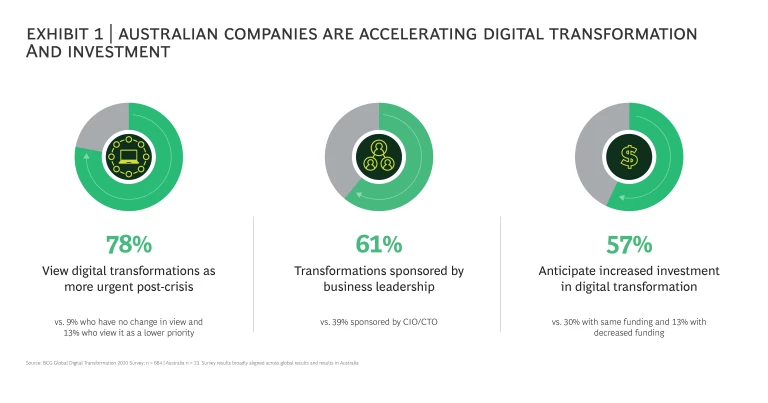With the disruptions of COVID-19, Australian companies have discovered that what they had planned for in years can now be done in months. This urgency to transform and the opportunities available to the companies brave enough to embrace digital are gaining pace. In a recent BCG survey, over three-quarters of CEOs said they plan to speed up their company’s digital transformation. Digital transformation is also shifting to the heart of a company; getting it right is so critical that 61% of transformations are being led by CEOs and their direct reports (see Exhibit 1).
The view of what’s possible in digital transformations has also expanded. When COVID-19 restrictions were implemented, digital channel use jumped. BCG’s Australian Consumer Sentiment Survey showed that in the two months from April 2020, the number of people buying online increased 8% compared to the same period in 2019. Further, one-quarter (24%) of people who bought retail online were first-time digital users for at least one new category, and half of those (47%) are likely to buy more online again. Wide-scale remote working also happened overnight. A recent BCG survey in Australia found that for people who can work remotely, 85% want to continue to work remotely in some form and only 15% want to return to the office full time.
Digital is here to stay, and being embraced by a wider group of customers, suppliers and employees (including those who were difficult to convince to move online before the crisis). In these more uncertain times, it helps to be prepared for different scenarios and digital leaders are quicker to respond. Consequently, CEOs are revising their objectives and raising their level of digital ambition, as goals that were set for two-to-three years seem now achievable within the next six months.
TOP-PERFORMING COMPANIES USE DIGITAL TRANSFORMATIONS TO COMBINE HUMAN AND TECHNOLOGICAL CAPABILITIES IN NEW WAYS
Digital transformation can sometimes be taken as automating existing processes. A true digital transformation imagines a new reality, made possible by shifts in consumer behaviour and technological innovations. It is not a question of human or machine, but of how companies can augment human capabilities with technological capabilities in novel ways to thrive in the new reality.
At BCG we refer to companies that focus their digital transformations on combining human and technological capabilities as bionic (see Exhibit 2). Bionic companies leverage the best of both sets of capabilities to achieve a step change in performance. They have a constant focus on better outcomes for their customers (how customer journeys, needs and channels are evolving), their suppliers (how to build a resilient and efficient digital supply chain), and their people (how to embed new ways of working).
Our research shows that companies that invest in combining these capabilities outperform their competitors overall, and on dimensions such as efficiency, product quality, customer satisfaction and speed to market (see Exhibit 3).
Many companies embark on digital projects to automate existing
processes. For example, RPA – robotic process automation – can be used to deliver incremental changes by automating rules-based business processes, realising cost efficiencies and enabling employees to devote more time to higher-value work. But a true step change in performance requires true digital transformation based on re-imagining how human and technological capabilities can work together, and changing the underlying skills and technology to embed them at scale. In our work with one company, we found that using AI could reduce forecasting errors by 25%, but the impact of combining AI with human expertise was twice as powerful and could reduce forecasting errors by 50%. Taking a view of combined capabilities can move projects beyond experiments that work on a small scale to delivering the full potential of their investment.
When human and technological capabilities are working together seamlessly, companies can move even faster in times of rapid change or to respond to persistent crisis. And companies that move fast will create advantage.
SUCCESSFUL COMPANIES INVEST IN DIGITAL TRANSFORMATIONS
Companies that understand this digital imperative are accelerating their transformations to keep pace with the disruptive forces of COVID-19, and they are positioned to take advantage of shifts in markets and consumer behaviour. This advantage is inherent for digital natives, with their digitally skilled workforces, modern technological capabilities, and an understanding that digital transformation is a continuous process.
e-commerce giant Amazon is an industry leader with its philosophy to “start with the customer and work backwards”. When the COVID-19 crisis started, Amazon’s speed of innovation and ways of working saw it maintain delivery speeds, despite sharp demand increases. Data and analytics, including predictive demand modelling, kept offers relevant and competitive. Amazon also acted quickly to protect customers by putting a stop to opportunistic price rises and false advertising. This customer focus, and ability to draw on the best of human and technological capabilities, has set Amazon up to respond quickly and grow at the same time.
Incumbents have a different set of legacy assets and capabilities, but many have started to close the digital gap. In a recent example, a European electrical distributor was under pressure from digital players, fixed price merchants and supplier disintermediation. To stabilise and then grow market share, the company engaged in a digital transformation aimed at improving commercial excellence and reconfiguring its supply chain. Tailored AI solutions and a new data platform resulted in personalised pricing, reduced churn and an increase in basket sizes through next best offers. The company also made the shift to a pull-based supply chain (vs. pushed by suppliers), and optimised inventory using advanced forecasting. To achieve these outcomes the transformation put an equal focus on people and processes: the company recruited a new AI team and worked with its sales team to customise solutions.
Australian companies have both the means and the opportunity to leap forward to the new reality. Locally available cloud infrastructure and services are mature and competitive. Consumers are digitally literate – Australia ranks fourth worldwide in smartphone penetration (81%) and ninth in mobile broadband speed, and the shift to working from home was rapid and successful. Australia also has a capable workforce and has been a net exporter of ICT skills until recently.
COMPANIES THAT MOVE FAST ARE BETTER EQUIPPED TO MANAGE DOWNTURNS AND TO LEAP INTO THE NEW REALITY
Australian companies that had started their digital transformations when COVID-19 restrictions came into place were better prepared for the downturn, and are now better prepared to take advantage of the new reality. While they were quick to react, they were also quick to adapt and thrive – on the frontline with their customers, behind the scenes in their supply chains, and with empowered teams using new ways of working.
In 2017, Telstra announced a highly ambitious investment plan to fund digital transformation, and to continue to invest in network advantage. Telstra’s objective was to radically simplify its product suite and re-create its digital product experience on a new technology stack. It is also streamlining and automating processes, and implementing agile working models at scale. The transformation is well underway, and has already achieved a substantially simplified consumer and enterprise product offering, significant productivity gains, and teams are using agile ways of working more broadly across the organisation.
In a crisis, a leading company will quickly change its focus from short-term response to setting up for the future. The deep, broad and long-term shifts emerging from COVID-19 are manifesting in new consumer, supplier and employee needs and expectations – making it critical for companies to digitally transform and reimagine how they operate and interact.
To understand how to compete in the new reality, companies will need to take an in-depth look at what they are doing and review it with the new reality in mind. Zero-based design guides companies through this process of re-imagining their future. Rather than focusing on incremental changes, zero-based design takes the company vision as the starting point, re-evaluates without any existing or perceived constraints, and then asks what needs to change to achieve the vision in the new reality. To reflect the deep shifts in response to COVID-19, we have identified three imperatives:
- The first imperative is to re-imagine customer journeys.Knowing what customers expect and how they want to interact in a post COVID-19 world will shape how digital and physical channels come together. Companies need to re-think their customer journeys to meet evolving engagement, selling and service expectations. Traditionally, digital channels have supported physical channels, but before long physical channels will be supporting digital-first channel strategies. A review of customer journeys can tap into what customers want and need so that a company can find a new balance between its online and physical channels, and more personalised ways to engage across both. Companies that do this well are the ones that meet customer expectations when things are going well, and if they go wrong.
- The second imperative is to build resilient supply chains. In a world where the production and flow of goods is changing, supply chains need to be resilient as well as efficient; the loss of sales or disrupted production has a far greater impact on company economics than the incremental cost savings of reducing input or transport costs. Australian companies need to make quick, integrated supply chain decisions at all times, let alone in times of crisis. Greater visibility of end-to-end supply chains, in real time, and in one place is vital. A digital twin – a holistic model of the entire supply chain – is a powerful tool to understand the supply chain and simulate different scenarios along the supply chain and throughout the buyer and supplier ecosystem.
- The third imperative is to change the way people work.COVID-19 has forced a rapid shift in where and how people work and has broken through longstanding barriers to change in just three months. Companies have an opportunity to challenge their traditional operations and decide which target work environment works best, and which rhythms and working norms (e.g., on-site/remote) are the most productive. A one-size-fits all approach no longer resonates with employees, and companies can tailor their employee value propositions to balance employee needs with business outcomes and the role of the office. A deliberate approach to designing the new work environment, rather than returning to the way it was before, starts from ‘tomorrow back’, not ‘yesterday forward’ – asking what really needs to go back to how it was, instead of how quickly and closely can things get back to how they used to be.
All three imperatives require companies to re-imagine how they combine human and technological capabilities in a digital transformation. There are two important enablers for doing this – the right technology set-up (a more modular and flexible environment) and the right talent set-up (digital skills and cross-functional teaming). Without these in place, digital transformations will not capture the full benefits, or be sustainable for the longer-term.
When electricity was first introduced into factories during the industrial revolution, factory floor layouts still followed old steam-powered processes. Before long, it became apparent that it would take more than replacing steam with electricity to speed up production – the more fundamental processes and architecture would also need to change. Henry Ford, recognising this, reorganised the Model T factory to harness the flexibility of electric power in a moving assembly line and cut the time to build a car from over 12 hours to two hours and 30 minutes.
Australia is now at a similar point of realisation in the digital revolution. So far, Australian companies have mainly applied technology to how things are done today, not what can be done. To win the rebound, companies will need to reinvent their processes by combining the best of human and technological capabilities to engage with customers, optimise supply chains, and shape work environments.
ACKNOWLDEGMENTS
The authors would like to acknowledge the many contributions to the research, writing and production of this report, including Eliza Spring, Jasmine Aurora, Cole Brown, Andy Wang, Brad Gyngell, Marissa Lynch, and Debbie Spears.









